
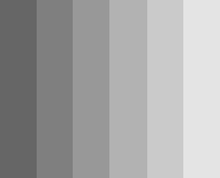
Mach bands is an optical illusion named after the physicist Ernst Mach. It exaggerates the contrast between edges of the slightly differing shades of gray, as soon as they contact one another, by triggering edge-detection in the human visual system.


Mach bands is an optical illusion named after the physicist Ernst Mach. It exaggerates the contrast between edges of the slightly differing shades of gray, as soon as they contact one another, by triggering edge-detection in the human visual system.
The Mach bands effect is due to the spatial high-boost filtering performed by the human visual system on the luminance channel of the image captured by the retina. Mach reported the effect in 1865, conjecturing that filtering is performed in the retina itself, by lateral inhibition among its neurons. [1] This conjecture is supported by observations on other (non-visual) senses, as pointed out by von Békésy. [2] The visual pattern is often found on curved surfaces subject to a particular, naturally-occurring illumination, so the occurrence of filtering can be explained as the result of learnt image statistics. The effect of filtering can be modeled as a convolution between a trapezoidal function that describes the illumination and one or more bandpass filters. A tight approximation is obtained by a model employing 9 even-symmetric filters scaled at octave intervals. [3]
The effect is independent of the orientation of the boundary.
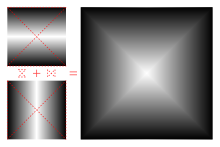
This visual phenomenon is important to keep in mind when evaluating dental radiographs for evidence of decay, in which grayscale images of teeth and bone are analyzed for abnormal variances of density. A false-positive radiological diagnosis of dental caries can easily arise if the practitioner does not take into account the likelihood of this illusion. Mach bands manifest adjacent to metal restorations or appliances[ citation needed ] and the boundary between enamel and dentin. [5] Mach bands may also result in the misdiagnosis of horizontal root fractures because of the differing radiographic intensities of tooth and bone. [6]
Mach effect can also lead to an erroneous diagnosis of pneumothorax by creating a dark line at the lung periphery (whereas a true pneumothorax will have a white pleural line). [7]

Mach bands can also appear when there is a discontinuity in the derivative of a gradient, a visual effect common when intensities are linearly interpolated such as in Gouraud shading.
Computer image processing systems use edge-detection in a way analogous to the brain, using unsharp masking to clarify edges in photos for example.
An illusion is a distortion of the senses, which can reveal how the mind normally organizes and interprets sensory stimulation. Although illusions distort the human perception of reality, they are generally shared by most people.

In visual perception, an optical illusion is an illusion caused by the visual system and characterized by a visual percept that arguably appears to differ from reality. Illusions come in a wide variety; their categorization is difficult because the underlying cause is often not clear but a classification proposed by Richard Gregory is useful as an orientation. According to that, there are three main classes: physical, physiological, and cognitive illusions, and in each class there are four kinds: Ambiguities, distortions, paradoxes, and fictions. A classical example for a physical distortion would be the apparent bending of a stick half immerged in water; an example for a physiological paradox is the motion aftereffect. An example for a physiological fiction is an afterimage. Three typical cognitive distortions are the Ponzo, Poggendorff, and Müller-Lyer illusion. Physical illusions are caused by the physical environment, e.g. by the optical properties of water. Physiological illusions arise in the eye or the visual pathway, e.g. from the effects of excessive stimulation of a specific receptor type. Cognitive visual illusions are the result of unconscious inferences and are perhaps those most widely known.

Color constancy is an example of subjective constancy and a feature of the human color perception system which ensures that the perceived color of objects remains relatively constant under varying illumination conditions. A green apple for instance looks green to us at midday, when the main illumination is white sunlight, and also at sunset, when the main illumination is red. This helps us identify objects.

A grid illusion is any kind of grid that deceives a person's vision. The two most common types of grid illusions are the Hermann grid illusion and the scintillating grid illusion.

The visual system comprises the sensory organ and parts of the central nervous system which gives organisms the sense of sight as well as enabling the formation of several non-image photo response functions. It detects and interprets information from the optical spectrum perceptible to that species to "build a representation" of the surrounding environment. The visual system carries out a number of complex tasks, including the reception of light and the formation of monocular neural representations, colour vision, the neural mechanisms underlying stereopsis and assessment of distances to and between objects, the identification of a particular object of interest, motion perception, the analysis and integration of visual information, pattern recognition, accurate motor coordination under visual guidance, and more. The neuropsychological side of visual information processing is known as visual perception, an abnormality of which is called visual impairment, and a complete absence of which is called blindness. Non-image forming visual functions, independent of visual perception, include the pupillary light reflex and circadian photoentrainment.

In neuroanatomy, the lateral geniculate nucleus is a structure in the thalamus and a key component of the mammalian visual pathway. It is a small, ovoid, ventral projection of the thalamus where the thalamus connects with the optic nerve. There are two LGNs, one on the left and another on the right side of the thalamus. In humans, both LGNs have six layers of neurons alternating with optic fibers.

The Cornsweet illusion, also known as the Craik–O'Brien–Cornsweet illusion or the Craik–Cornsweet illusion, is an optical illusion that was described in detail by Tom Cornsweet in the late 1960s. Kenneth Craik and Vivian O'Brien had made earlier observations in a similar vein.

As a part of the retina, bipolar cells exist between photoreceptors and ganglion cells. They act, directly or indirectly, to transmit signals from the photoreceptors to the ganglion cells.

A chest radiograph, called a chest X-ray (CXR), or chest film, is a projection radiograph of the chest used to diagnose conditions affecting the chest, its contents, and nearby structures. Chest radiographs are the most common film taken in medicine.

Motion perception is the process of inferring the speed and direction of elements in a scene based on visual, vestibular and proprioceptive inputs. Although this process appears straightforward to most observers, it has proven to be a difficult problem from a computational perspective, and difficult to explain in terms of neural processing.

The wagon-wheel effect is an optical illusion in which a spoked wheel appears to rotate differently from its true rotation. The wheel can appear to rotate more slowly than the true rotation, it can appear stationary, or it can appear to rotate in the opposite direction from the true rotation.

The Hering illusion is one of the geometrical-optical illusions and was discovered by the German physiologist Ewald Hering in 1861. When two straight and parallel lines are presented in front of radial background, the lines appear as if they were bowed outwards. The Orbison illusion is one of its variants, while the Wundt illusion produces a similar, but inverted effect.
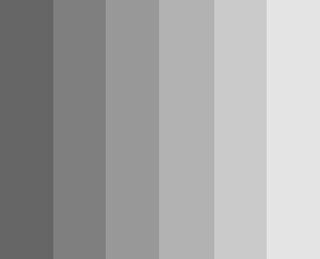
In neurobiology, lateral inhibition is the capacity of an excited neuron to reduce the activity of its neighbors. Lateral inhibition disables the spreading of action potentials from excited neurons to neighboring neurons in the lateral direction. This creates a contrast in stimulation that allows increased sensory perception. It is also referred to as lateral antagonism and occurs primarily in visual processes, but also in tactile, auditory, and even olfactory processing. Cells that utilize lateral inhibition appear primarily in the cerebral cortex and thalamus and make up lateral inhibitory networks (LINs). Artificial lateral inhibition has been incorporated into artificial sensory systems, such as vision chips, hearing systems, and optical mice. An often under-appreciated point is that although lateral inhibition is visualised in a spatial sense, it is also thought to exist in what is known as "lateral inhibition across abstract dimensions." This refers to lateral inhibition between neurons that are not adjacent in a spatial sense, but in terms of modality of stimulus. This phenomenon is thought to aid in colour discrimination.
Visual neuroscience is a branch of neuroscience that focuses on the visual system of the human body, mainly located in the brain's visual cortex. The main goal of visual neuroscience is to understand how neural activity results in visual perception, as well as behaviors dependent on vision. In the past, visual neuroscience has focused primarily on how the brain responds to light rays projected from static images and onto the retina. While this provides a reasonable explanation for the visual perception of a static image, it does not provide an accurate explanation for how we perceive the world as it really is, an ever-changing, and ever-moving 3-D environment. The topics summarized below are representative of this area, but far from exhaustive. To be less topic specific, one can see this textbook for the computational link between neural activities and visual perception and behavior: "Understanding vision: theory, models, and data", published by Oxford University Press 2014.
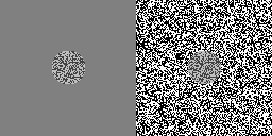
The Chubb illusion is an optical illusion or error in visual perception in which the apparent contrast of an object varies substantially to most viewers depending on its relative contrast to the field on which it is displayed. These visual illusions are of particular interest to researchers because they may provide valuable insights in regard to the workings of human visual systems.
“Lateral periodontal cysts (LPCs) are defined as non-keratinised and non-inflammatory developmental cysts located adjacent or lateral to the root of a vital tooth.” LPCs are a rare form of jaw cysts, with the same histopathological characteristics as gingival cysts of adults (GCA). Hence LPCs are regarded as the intraosseous form of the extraosseous GCA. They are commonly found along the lateral periodontium or within the bone between the roots of vital teeth, around mandibular canines and premolars. Standish and Shafer reported the first well-documented case of LPCs in 1958, followed by Holder and Kunkel in the same year although it was called a periodontal cyst. Since then, there has been more than 270 well-documented cases of LPCs in literature.
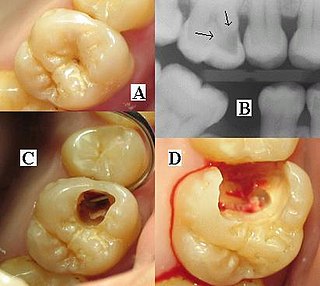
Dental radiographs, commonly known as X-rays, are radiographs used to diagnose hidden dental structures, malignant or benign masses, bone loss, and cavities.
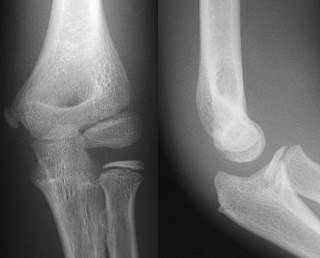
Projectional radiography, also known as conventional radiography, is a form of radiography and medical imaging that produces two-dimensional images by X-ray radiation. The image acquisition is generally performed by radiographers, and the images are often examined by radiologists. Both the procedure and any resultant images are often simply called 'X-ray'. Plain radiography or roentgenography generally refers to projectional radiography. Plain radiography can also refer to radiography without a radiocontrast agent or radiography that generates single static images, as contrasted to fluoroscopy, which are technically also projectional.

A panoramic radiograph is a panoramic scanning dental X-ray of the upper and lower jaw. It shows a two-dimensional view of a half-circle from ear to ear. Panoramic radiography is a form of focal plane tomography; thus, images of multiple planes are taken to make up the composite panoramic image, where the maxilla and mandible are in the focal trough and the structures that are superficial and deep to the trough are blurred.
Oblique effect is the name given to the relative deficiency in perceptual performance for oblique contours as compared to the performance for horizontal or vertical contours.